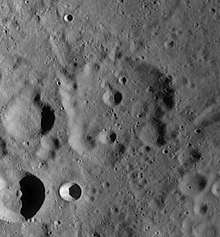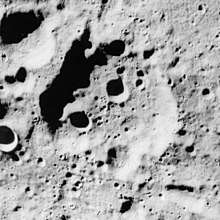Soddy (crater)
Soddy is an eroded lunar impact crater lying on the far side of the Moon, invisible from the Earth, to the south-southeast of the prominent crater King. Material from the ray system surrounding King covers the sides and interior of Soddy. Less than one crater diameter to the west of Soddy is the smaller Heron.
 LRO image | |
| Coordinates | 0.4°N 121.8°E |
|---|---|
| Diameter | 42 km |
| Depth | Unknown |
| Colongitude | 239° at sunrise |
| Eponym | Frederick Soddy |

The crater is named after the British physicist Frederick Soddy who was also a Nobel laureate.[1]
This crater has been heavily worn and eroded, so that only a remnant of a crater depression survives. There are small craterlets along the rim edge to the southwest and southeast. The interior is uneven and almost indistinguishable from the surrounding terrain.
Satellite craters
By convention these features are identified on lunar maps by placing the letter on the side of the crater midpoint that is closest to Soddy.
| Soddy | Latitude | Longitude | Diameter |
|---|---|---|---|
| E | 0.8° N | 123.4° E | 16 km |
| G | 0.5° N | 123.5° E | 13 km |
| P | 0.4° S | 120.9° E | 8 km |
| Q | 0.5° S | 120.2° E | 24 km |
References
- "Soddy (crater)". Gazetteer of Planetary Nomenclature. USGS Astrogeology Research Program.
- Andersson, L. E.; Whitaker, E. A. (1982). NASA Catalogue of Lunar Nomenclature. NASA RP-1097.CS1 maint: ref=harv (link)
- Bussey, B.; Spudis, P. (2004). The Clementine Atlas of the Moon. New York: Cambridge University Press. ISBN 978-0-521-81528-4.CS1 maint: ref=harv (link)
- Cocks, Elijah E.; Cocks, Josiah C. (1995). Who's Who on the Moon: A Biographical Dictionary of Lunar Nomenclature. Tudor Publishers. ISBN 978-0-936389-27-1.CS1 maint: ref=harv (link)
- McDowell, Jonathan (July 15, 2007). "Lunar Nomenclature". Jonathan's Space Report. Retrieved 2007-10-24.CS1 maint: ref=harv (link)
- Menzel, D. H.; Minnaert, M.; Levin, B.; Dollfus, A.; Bell, B. (1971). "Report on Lunar Nomenclature by the Working Group of Commission 17 of the IAU". Space Science Reviews. 12 (2): 136–186. Bibcode:1971SSRv...12..136M. doi:10.1007/BF00171763.CS1 maint: ref=harv (link)
- Moore, Patrick (2001). On the Moon. Sterling Publishing Co. ISBN 978-0-304-35469-6.CS1 maint: ref=harv (link)
- Price, Fred W. (1988). The Moon Observer's Handbook. Cambridge University Press. ISBN 978-0-521-33500-3.CS1 maint: ref=harv (link)
- Rükl, Antonín (1990). Atlas of the Moon. Kalmbach Books. ISBN 978-0-913135-17-4.CS1 maint: ref=harv (link)
- Webb, Rev. T. W. (1962). Celestial Objects for Common Telescopes (6th revised ed.). Dover. ISBN 978-0-486-20917-3.CS1 maint: ref=harv (link)
- Whitaker, Ewen A. (1999). Mapping and Naming the Moon. Cambridge University Press. ISBN 978-0-521-62248-6.CS1 maint: ref=harv (link)
- Wlasuk, Peter T. (2000). Observing the Moon. Springer. ISBN 978-1-85233-193-1.CS1 maint: ref=harv (link)